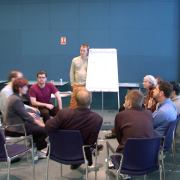Table of contents: W3C Patent Policy | W3C Advisory Board | W3C Technical Architecture Group |
Most W3C work revolves around the standardization of Web technologies. To accomplish this work, W3C follows processes that promote the development of high-quality standards based on community consensus. All stakeholders can have a voice in the development of W3C standards, including Members large and small, as well as the public. W3C processes promote fairness, responsiveness, and progress: all facets of the W3C mission.

Breakout session, Bristol, UK
In February 2004, W3C adopted a Patent Policy to enable continued innovation and widespread adoption of Web standards developed by the World Wide Web Consortium. The W3C Patent Policy is designed to:
For additional information about the W3C Patent Policy, please refer to the Overview and Summary of W3C Patent Policy, discussion of the Business Benefits of the W3C Patent Policy, Patent Policy FAQ, and Patent Policy Fact Sheet (which has statistics about the policy in practice).
The W3C Advisory Board (AB) was created in March 1998 to provide guidance to the Team on issues of strategy, management, legal matters, process, and conflict resolution. The Advisory Board, which is elected by the Advisory Committee, is not a board of directors and has no decision-making authority within W3C; its role is strictly advisory.
The Advisory Board manages the evolution of the W3C Process Document. The Process Document governs W3C's operations and describes the processes W3C follows in pursuit of its mission. It is a public document divided into sections that cover the W3C organization, W3C Activities and groups, how consensus governs W3C work, the W3C Recommendation Track, and the W3C Submission Process.
The W3C Technical Architecture Group (TAG) was created in July 2001 to provide stewardship of the Web architecture. The TAG elucidates cross-technology Web architecture principles, and helps to resolve Web architectural issues that arise within and outside of W3C. Like other W3C Working Groups, the TAG uses the W3C Recommendation Track to build consensus around its documents. In 2004, the TAG published Architecture of the World Wide Web, Volume I.
Copyright © 2004-2005 W3C® (MIT, ERCIM, Keio), All Rights Reserved. W3C liability, trademark, document use and software licensing rules apply. Your interactions with this site are in accordance with our public and Member privacy statements.
Photo credit: Ian Jacobs